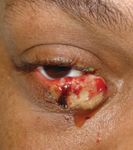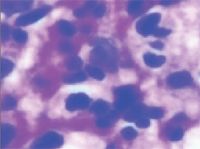A persistent crusted plaque on the lower eyelid
A 17-year-old HIV/AIDS patient presents with persistent crusted plaque, 6 day post valacyclovir treatment revealed dramatic reduction in exudate and granulation tissue.
The photograph included in the Dermatology, What's Your Diagnosis article titled A Persistent Crusted Plaque on the Lower Eyelid in the May 2007 issue was described as being of a 17-year old boy with HIV/AIDS. In fact, it was a photograph of a 34-year old man with HIV/AIDS. The text of the article is otherwise accurate. The reader is reminded that cases presented in this column are published as teaching cases and may very well include information and photographs from an amalgam of cases.

• What's the diagnosis? • How would you manage this adolescent?
Skin examination revealed a single 2-cm x 1.5-cm fungating, exophytic tumor on the right lower eyelid margin. The lesion exhibited involvement of the palpebral conjunctiva but sparing of the bulbar conjunctiva. The surface was moist, with a yellow exudate and hemorrhagic crusting. On palpation the mass was firm but not friable. A shave biopsy of the lesion was sent for histopathology and culture, and valacyclovir (Valtrex) 500-mg orally three times daily was initiated because of concern that this lesion might represent a herpes simplex virus infection (HSV).
Diagnosis and treatment


This clinical presentation of HSV infection with persistent verrucous plaques is referred to as herpes simplex vegetans, and is found exclusively in immunosuppressed individuals including those with HIV/AIDS and hereditary immunodeficiency.2,3 Herpes simplex vegetans in the genital and perianal areas must be distinguished from human papillomavirus-induced condyloma and squamous cell carcinoma.3 Moreover, these lesions are frequently resistant to acyclovir, and progression of the eruption while on treatment or failure to respond to appropriate therapy should prompt an evaluation for acyclovir resistance and consideration of treatment with foscarnet (Foscavir) and newer antiviral agents.
References
1. Reyes M, Shaik NS, Graber JM, et al: Acyclovir-resistant genital herpes among persons attending sexually transmitted disease and human immunodeficiency virus clinics. Arch Intern Med 2003;163:76
2. Abbo L, Vince KD, Dickinson G, et al: Selective defect in plasmacyoid dendritic cell function in a patient with AIDS-associated atypical genital herpes simplex vegetans treated with imiquimod. Clinic Infect Dis 2007;44:e25
3. Beasley KL, Cooley GE, Kao GF, et al: Herpes simplex vegetans: Atypical genital herpes simplex infection in a patient with common variable immunodeficiency. J Am Acad Dermatol 1997,37(5 Pt2):860
Please see Dr. Cohen's Web site, www.dermatlas.org, for additional images